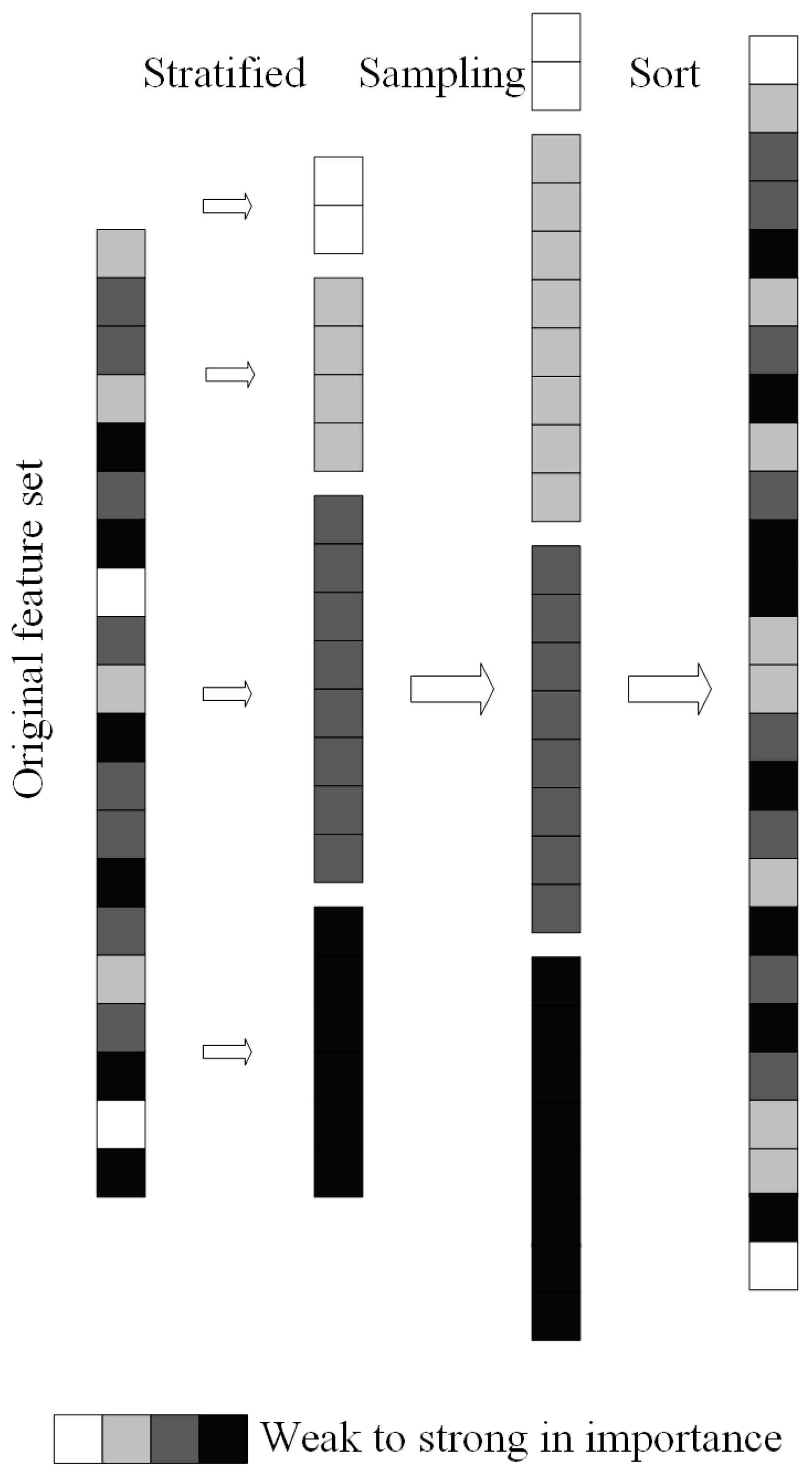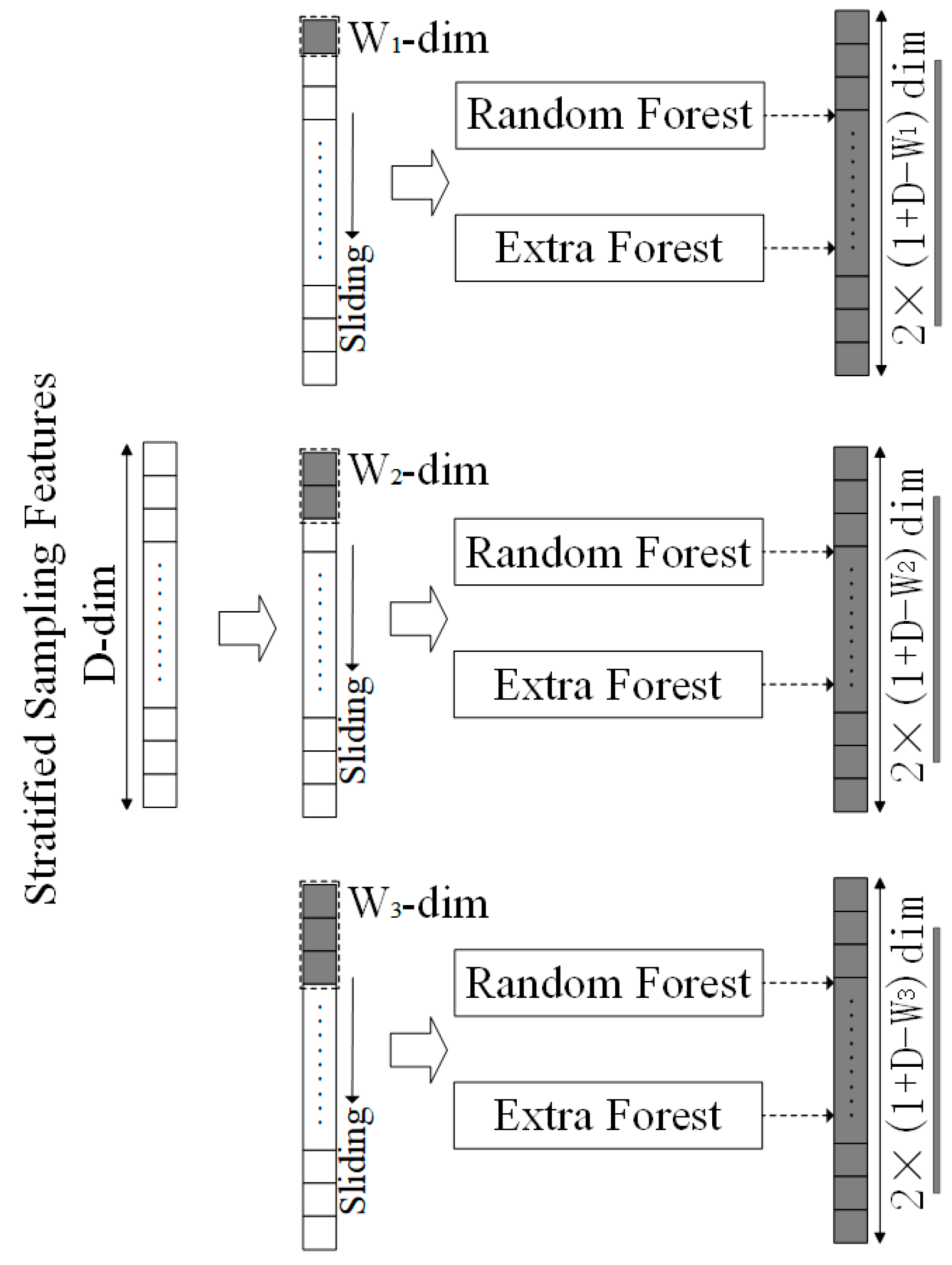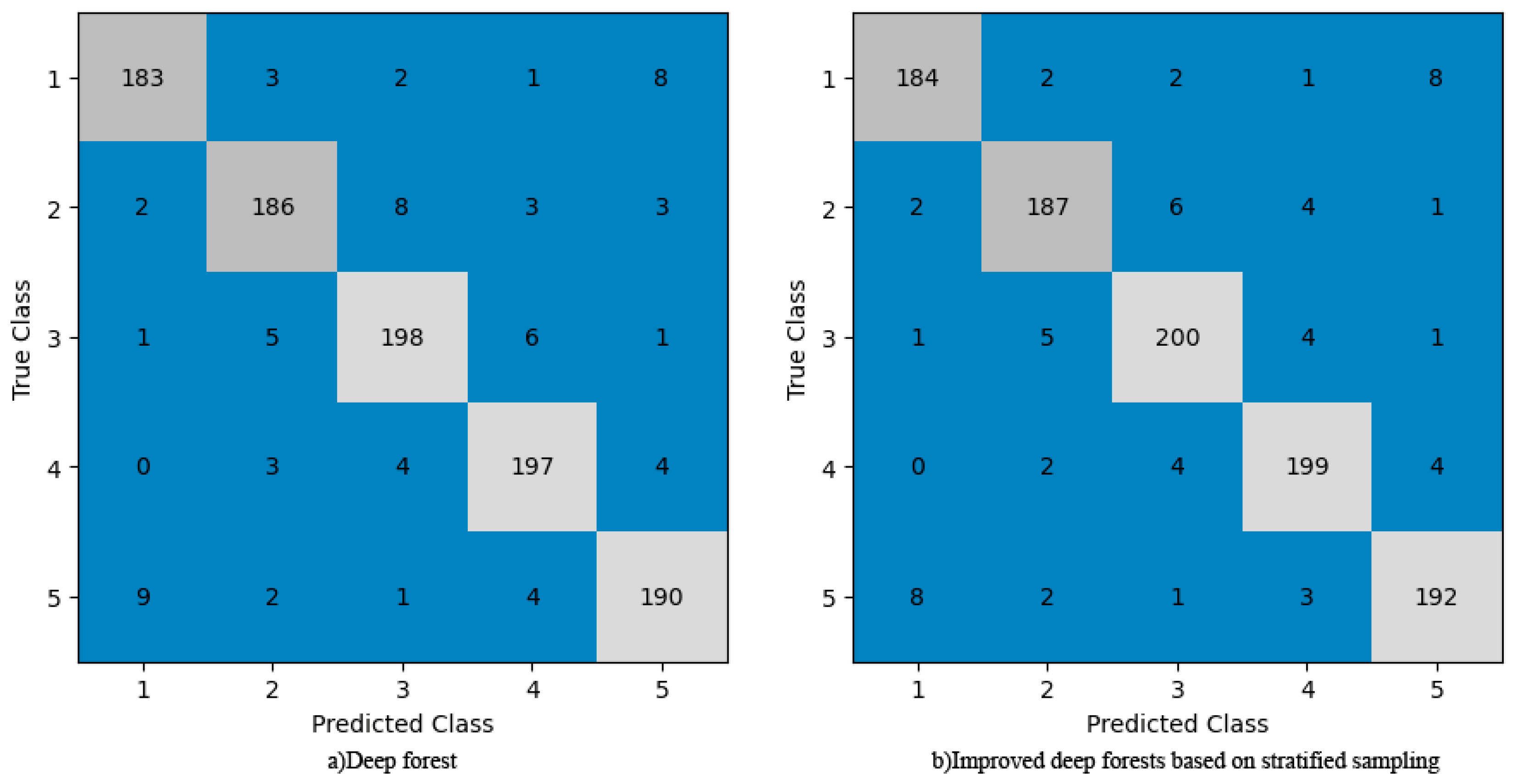Nuclear Family Type Identification Based on Deep Forest Algorithm in Residential Power Consumption
Abstract
1. Introduction
2. Family Type Identification Model
2.1. Stratified Sampling
2.2. Multi-Grained Scanning
2.3. Cascade Forest
2.4. Identification Process
3. Experimental
3.1. Data Cleaning
3.2. Feature Engineering
3.3. Identification
4. Example Analysis
4.1. Different Time Periods’ Experiment
4.2. Improved Algorithms’ Experiment
5. Discussion and Conclusions
Author Contributions
Funding
Informed Consent Statement
Data Availability Statement
Acknowledgments
Conflicts of Interest
References
- Zhang, X.D.; Zhang, Y.L.; Jia, G.P.; Tang, M.J.; Chen, G.; Zhang, L. Research Progress on Low Fertility Rate in China: A Literature Review. Popul. Dev. 2021, 5, 39–48. [Google Scholar]
- Hu, Z.; Peng, X.Z.; Wang, X.H. The current cognitive misunderstanding in the field of family changes and family policy in country. Study Pract. 2018, 11, 101–108. [Google Scholar]
- Tong, H.J.; Song, D. Analysis of the characteristics and development Trend of family structure in China. J. Shenzhen Univ. Humanit. Soc. Sci. 2016, 33, 118–123+149. [Google Scholar]
- Wang, Y.S. Family structure in the mid and late 18th century in China. Soc. Sci. China 2000, 2, 167–177+209. [Google Scholar]
- Chen, Y.Y. Problems an countermeasures in the implementation of the ladder electricity price policy in Huizhou city. Master’s Thesis, Guangxi Normal University, Guilin, China, 2019. [Google Scholar]
- Sun, L.; Tian, M. Study on migration mode in nuclear family of migrants: Based on the perspective of family life cycle theory. Hum. Geogr. 2021, 4, 48–82. [Google Scholar]
- Xu, C.Q.; Zhao, H.D.; Song, X.H. Research on method of power user group identification and analysis based on large data. Zhengzhou Univ. Nat. Sci. Ed. 2016, 48, 113–117. [Google Scholar]
- Zhu, T.Y.; Ai, Q.; He, X.; Li, Z.L.; Sun, D.L.; Li, X.L. An Overview of Data-driven Electricity Consumption Behavior. Power Syst. Technol. 2020, 44, 3497–3507. [Google Scholar] [CrossRef]
- Shuai, C.Y.; Yang, H.C.; Ouyang, X.; He, M.W.; Gong, Z.W.Y.; Shu, W.N. Analysis and Identification of Power Blackout-Sensitive Users by Using Big Data in the Energy System. IEEE Access. 2019, 7, 19488–19501. [Google Scholar] [CrossRef]
- Lu, Z.M.; Chen, J.Y.; Li, J.; Xie, Y.; Jiang, X.L.; Han, L.; Guo, Q. An empty-nest power user identification method based on weighted random forest algorithm. Telecommun. Sci. 2020, 36, 112–121. [Google Scholar]
- Shen, H.T.; Zhang, C.; Li, C.R.; Wu, Y.D. Load identification of coal to electricity users based on intelligent algorithm. Electr. Meas. Instrum. 2020. Available online: http://kns.cnki.net/kcms/detail/23.1202.TH.20201126.1747.015.html (accessed on 20 May 2023).
- Niu, N.; Jin, H. Identifying urban households in relative poverty with multi-source data: A case study in Zhengzhou. J. Urban Aff. 2022. [Google Scholar] [CrossRef]
- Zhou, L.; Zhang, Y.; Liu, S.; Li, K.; Li, C.B.; Yi, Y.Q.; Tang, J. Consumer phase identification in low-voltage distribution network considering vacant users. Int. J. Electr. Power Energy Syst. 2020, 121, 106079. [Google Scholar] [CrossRef]
- Cai, J.; Xie, H.; Wu, G.X.; Tang, X.L.; Zhou, M. User data identification of power distribution system based on multi—Model hierarchical fusion. Adv. Technol. Electr. Eng. Energy 2022, 41, 49–58. [Google Scholar]
- Li, Q.S.; Wang, Y.; Sun, Y.J.; Xiao, Y.; Ou, Y.T. Application of BP neural network in electricity users classification. Mod. Electron. Tech. 2017, 40, 156–158+162. [Google Scholar] [CrossRef]
- Zhou, Z.H.; Feng, J. Deep forest: Towards an alternative to deep neural networks. IJCAI 2017, 3553–3559. [Google Scholar]
- Lawal, A.S.; Servadio, J.L.; Davis, T.; Ramaswami, A.; Botchwey, N.; Russell, A.G. Orthogonalization and machine learning methods for residential energy estimation with social and economic indicators. Appl. Energy 2021, 283, 116114. [Google Scholar] [CrossRef]
- Saoud, L.S.; Al-Marzouqi, H.; Hussein, R. Household Energy Consumption Prediction Using the Stationary Wavelet Transform and Transformers. IEEE Access. 2022, 10, 5171–5183. [Google Scholar] [CrossRef]
- Mohi-Ud-Din, G.; Marnerides, A.K.; Shi, Q.; Dobbins, C.; MacDermott, A. Deep COLA: A Deep COmpetitive Learning Algorithm for Future Home Energy Management Systems. IEEE Trans. Emerg. Top. Comput. Intell. 2021, 5, 860–870. [Google Scholar] [CrossRef]
- Abreu, J.M.; Pereira, F.C.; Ferrao, P. Using pattern recognition to identify habitual behavior in residential electricity consumption. Energy Build. 2012, 49, 479–487. [Google Scholar] [CrossRef]
- Creswell, A.; White, T.; Dumoulin, V.; Arulkumaran, K.; Sengupta, B.; Bharath, A.A. Generative Adversarial Networks: An Overview. IEEE Signal Process. Mag. 2018, 35, 53–56. [Google Scholar] [CrossRef]
- Commission for Energy Regulation. CER Smart Metering Projectelectricity Customer Behavior Trial, 1st ed.; Commission for Energy Regulation: Dublin, Germany, 2012; Available online: https://www.ucd.ie/issda/data/commissionforenergyregulationcer/ (accessed on 20 May 2023).
- Wang, J.; Wu, X.M.; Wang, A.F. The application of pearson correlation coefficient algorithmin in searching for the users with abnormal watt-hour meters. Power Demand Side Manag. 2014, 16, 52–54. [Google Scholar]
- Qiu, Y.; Li, S.; Jin, L.; Zhang, M.M.; Wang, J. Bridge Anomaly Monitoring Data Identification Method Based on the Statistical Feature Mixture and Random Forest Permutation Importance Index. Chin. J. Sens. Actuators 2022, 35, 756–762. [Google Scholar]
- Han, H.; Wang, W.Y.; Mao, B.H. Borderline-SMOTE: A New Over-Sampling Method in Imbalanced Data Sets Learning. Lect. Notes Comput. Sci. 2005, 878–887. [Google Scholar]
- Shaukat, M.A.; Shaukat, H.R.; Qadir, Z.; Munawar, H.S.; Kouzani, A.Z.; Mahmud, M.A.P. Cluster analysis and model comparison using smart meter data. Sensors 2021, 21, 3157. [Google Scholar] [CrossRef] [PubMed]
- Wang, W.; Yang, D.; Huang, Z.; Hu, H.; Wang, L.; Wang, K. Electrodeless nanogenerator for dust recover. Energy Technol. 2022, 10, 699. [Google Scholar] [CrossRef]
- Guo, Y.; Yang, D.; Zhang, Y.; Wang, L.; Wang, K. Online estimation of SOH for lithium-ion battery based on SSA-Elman neural network. Prot. Control. Mod. Power Syst. 2022, 7, 40. [Google Scholar] [CrossRef]






| Family Type | 2 Adults and 0 Child | 2 Adults and 1 Child | 2 Adults and 2 Child | 2 Adults and 3 Child | Other Families |
|---|---|---|---|---|---|
| Number of households | 682 | 127 | 74 | 61 | 100 |
| Label | 0 | 1 | 2 | 3 | 4 |
| Actual | Predicted | |
|---|---|---|
| Positive | Negative | |
| Positive | TP | FN |
| Negative | FP | TN |
| Models | Acc (%) |
|---|---|
| Random Forest | 88.9 |
| Deep Forest | 93.3 |
| Deep Forest Based On Stratified Sampling | 93.6 |
| Improved Deep Forest | 93.8 |
| Deep Forest Based On Improved Stratified Sampling | 94.0 |
Disclaimer/Publisher’s Note: The statements, opinions and data contained in all publications are solely those of the individual author(s) and contributor(s) and not of MDPI and/or the editor(s). MDPI and/or the editor(s) disclaim responsibility for any injury to people or property resulting from any ideas, methods, instructions or products referred to in the content. |
© 2023 by the authors. Licensee MDPI, Basel, Switzerland. This article is an open access article distributed under the terms and conditions of the Creative Commons Attribution (CC BY) license (https://creativecommons.org/licenses/by/4.0/).
Share and Cite
Huang, Z.; Wang, H. Nuclear Family Type Identification Based on Deep Forest Algorithm in Residential Power Consumption. Appl. Sci. 2023, 13, 6602. https://doi.org/10.3390/app13116602
Huang Z, Wang H. Nuclear Family Type Identification Based on Deep Forest Algorithm in Residential Power Consumption. Applied Sciences. 2023; 13(11):6602. https://doi.org/10.3390/app13116602
Chicago/Turabian StyleHuang, Zhaoxiang, and Hangjun Wang. 2023. "Nuclear Family Type Identification Based on Deep Forest Algorithm in Residential Power Consumption" Applied Sciences 13, no. 11: 6602. https://doi.org/10.3390/app13116602
APA StyleHuang, Z., & Wang, H. (2023). Nuclear Family Type Identification Based on Deep Forest Algorithm in Residential Power Consumption. Applied Sciences, 13(11), 6602. https://doi.org/10.3390/app13116602





